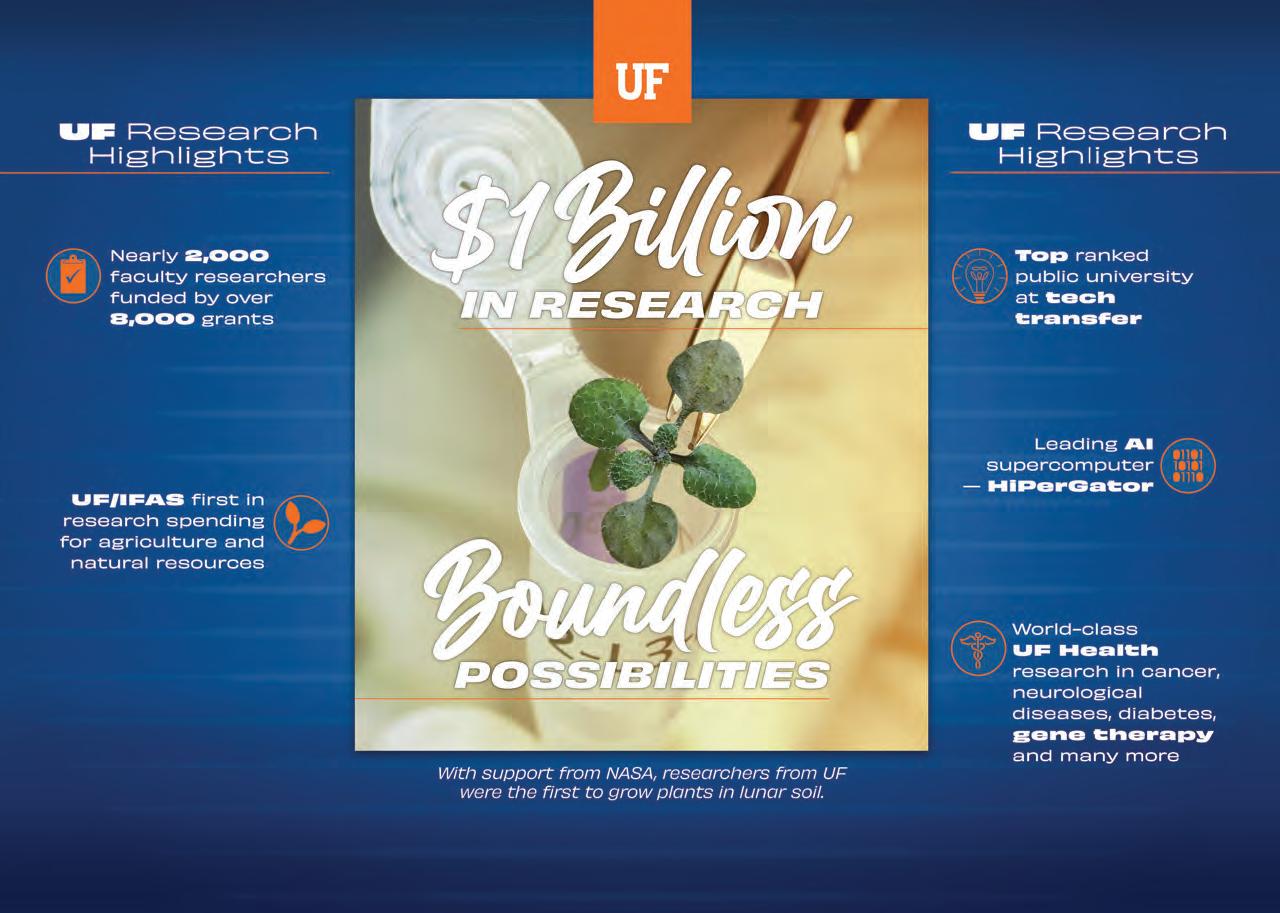FALL 2022

Field TesTed Removing barriers to STEM careers

The
About the cover: Geologist Anita Marshall with student Francesca Butler at Marshall's accessible field camp in Arizona.







About the cover: Geologist Anita Marshall with student Francesca Butler at Marshall's accessible field camp in Arizona.






The University of Florida surpassed $1 billion in research spending in 2022, joining an exclusive group of only about a dozen public universities to reach that milestone. We’ve come a long way since our first grants of just a few thousand dollars from the National Science Foundation in the early 1950s, but while the scale is different, the goals are the same to make important discoveries about the world in which we live, translate these insights into relevance, and educate the next generation of scientists and scholars.
One of those early NSF grants was to Archie Carr, a pioneering biologist whose research on sea turtles helped to save the species from extinction and put UF on the map as a research institution. In the 70 years since then, our faculty have helped to introduce dozens of products to Florida agriculture; provided new treatments for glaucoma, hepatitis, cancers and many other illnesses; broadened our understanding of the universe through discoveries of gravitational waves and exoplanets; and advanced scholarship about Christopher Columbus, the ancient Mayans, butterflies and countless other subjects.
Across all 16 colleges and hundreds of centers and institutes, UF researchers are helping to make life better. In this issue of Explore, we show how one faculty member’s disabling accident motivated her to make scientific fieldwork more accessible. We turn to our top business researchers for a better understanding of how people will work in the future. We learn about the history of the magnificent bald eagle and how UF researchers helped save it from extinction. And, we see how UF astronomy researchers are looking out into the universe, and back at our own planet.
UF research impacts people in Florida, in the United States and around the world. It provides answers to questions, it provides solutions to problems and it has a significant economic impact on our state.
John JerniganI
n one of the most intensive uses yet of the University of Florida’s HiPerGator supercomputer, UF engineers have accurately reproduced the turbulence and complexity of hot air rising along a wall a previously impossible simulation with applications in home fire safety and heating and cooling.
Such a fine-grained and detailed simulation of so-called thermal wall plumes has not been possible in the past because of the complexity of the air movements. But thanks to dedicated use of 90% of the HiPerGator’s AI cluster over several days, the research team led by UF engineering professor Sivaramakrishnan Balachandar was able to track turbulent eddies of air twisting and swirling on the sub-millimeter level.
“We used nearly the entire HiPerGator AI cluster to solve a problem which has hitherto not been solved in our community at this level of detail,” Balachandar said. “Turbulent flow is one of the grand challenges in science and engineering. Turbulence affects us everywhere, from airplane performance, to hurricane tracks and volcanic plumes.”
Thermal wall plumes occur when hot, buoyant air rises along a vertical surface. This process takes place during house fires and can spread fires quickly if not contained. But less destructive thermal wall plumes happen every day as heated or cooled air rises or sinks along the walls in interior spaces. Very similar processes explain mudslides and sediment-laden currents plumes turned on their side.
Many scientists have studied thermal plumes experimentally, but this requires building expensive test sites and is limited by the number of sensors that can be
placed on a wall. Those sensors also affect the very measurements that are being taken, muddying the data.
Computer models of thermal wall plumes solve many of the issues of realworld experiments, but the kinds of simulations that can run on an everyday computer are fuzzy and low-resolution. The millimeter-by-millimeter scale accomplished by Balachandar’s team requires the resources of a powerful supercomputer.

The researchers designed their simulation to replicate air movements in a real home. Virtually, they introduced warm air at the bottom of a wall along the baseboard and watched it evolve over time as it rose. The simulated house had vertical walls and roof lines of different slopes along which the thermal plumes developed, just like what would occur in a real home.
“What the computer simulation gives us is unprecedented access into all the details of what happens inside. We can go into the wall plume and see every nook
and cranny,” Balachandar said.
Overall, the researchers tracked nearly 100 billion components, such as velocity, pressure and temperature, over a quarter-million instants in time. The work required 125 of the 140 nodes of the HiPerGator AI cluster. Each node hosts eight GPUs and 128 CPUs, which each perform different kinds of calculations. Balachandar’s team optimized their code to run on the NVIDIA GPUs that power the AI cluster nodes, further improving the performance of their simulation.
These kinds of detailed simulations also cascade down toward practical applications. For example, engineers use much simpler models — with possibly faulty assumptions baked in — to help them design and understand home heating systems or fire codes. Improving those models can make these designs better.
“Now we can test existing models and find out where they come up short,” Balachandar said.
Eric Hamilton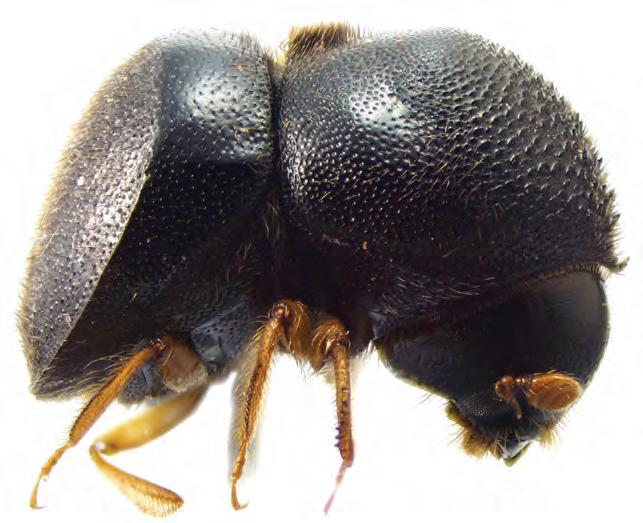
University of Florida entomologist Jiri Hulcr loves each of the 6,000 species of bark beetles, and he wants you to appreciate them, too. In his new book “The Surprising Lives of Bark Beetles,” co-authored by Ig Nobel Prize founder Marc Abrahams, Hulcr makes a case for caring about these tiny foresters.
Bark beetles have a symbiotic relationship with fungus, which they eat but also sow, gathering spores into an orifice called a mycangium and moving them to new locations. (They also steal other beetles’ fungus, which is called mycocleptism.)
The comb-overs and frizzy fringes of female beetles are not only dashing, but play a key role in the “nuptial dance” that precedes mating.
Some have abdomens shaped like bottle stoppers, which they use to plug the holes they drill in trees to keep competitors out. They also fart pheromones.
4. Their homes fooled the art world
Czech artist Hana Nováková made a point about conservation by displaying intricate bark beetle carvings in a gallery and pretending they were art.

5.
Bark beetles get a bad rap for destroying forests, which they certainly can, especially when imported by humans to places where the trees lack natural defenses. But in the natural forests they evolved to tend, they’re “an essential force in the long-term health of the ecosystem,” Hulcr writes, weeding out sick and stressed trees and increasing bug and bird diversity.
Some species are so good at smelling the ethanol released by stressed trees that they find it elsewhere, boring holes into plastic gasoline containers in their search for nutrients.
Coffee berry borers have developed a way around the defenses coffee plants use to deter pests, aka caffeine. The borers, who can neutralize and digest caffeine, have spread beyond their native range through human activity and now threaten coffee harvests worldwide. You don’t have to love bark beetles, but that fact might be proof enough that they’re worth noticing.
Alisson Clark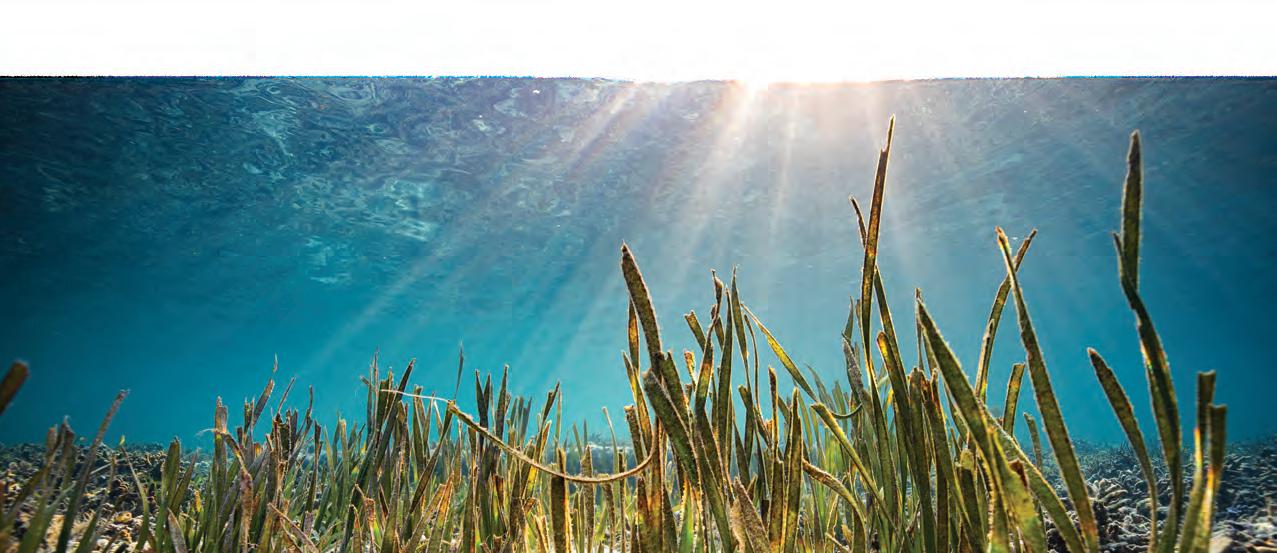
are vital to the marine ecosystem, where they provide food, habitat, shelter and other services for humans and aquatic organisms. But while seagrass success is threatened by a few factors, including human activities like boating, a crystallized version of human waste could be the answer to revitalizing these marine habitats.
Urine, it turns out, includes two key ingredients in plant fertilizers: phosphorus and nitrogen. Even better, wastewater treatment facilities already process this abundant resource and create byproducts that would otherwise be sent to the landfill.
In its crystallized form, this byproduct is called struvite, the material applied to seagrass in a recent study led by University of Florida scientists.
“Struvite occurs during the wastewater treatment process because magnesium, ammonia and phosphate are all readily available to form the crystal byproduct,” said Conor MacDonnell, who carried out the study as a Ph.D. student in the UF/IFAS department of soil, water, and ecosystem sciences. “The result is a relatively insoluble, sustainable compound found in wastewater treatment plants.”
That relative insolubility led MacDonnell – who earned his degree in 2021 and now works as a UF postdoctoral associate studying seagrass restoration – to team up with Gdańsk University of Technology student Franciszek Bydalek and UF/IFAS faculty members Patrick Inglett and Todd Osborne to investigate whether struvite could be used to fertilize seagrass.
“Coastal ecosystems are dependent upon seagrasses,” Inglett said. “As they diminish, it leads to problems like declining water quality and marine life dying off or migrating to other areas.”
To add to the challenges, current methods of seagrass restoration are relatively expensive and unsuccessful compared to other coastal ecosystems. The study points to nutrient-related issues and competition with algae as reasons behind these difficulties.
In the study, scientists grew three types of plots of seagrass in a simulated setting at the UF Whitney Laboratory for Marine Bioscience. One type received an application of struvite, another received a common controlled-release fertilizer, and the last received no fertilizer. Two experiments were conducted, testing different dosages of fertilizer.
“From the two experiments, we found struvite performed better than the controlled-release fertilizer in seagrass growth,” MacDonnell said. “Struvite seems to provide a slower, more consistent release of nutrients to the seagrass.”
The advantages of using struvite in these efforts, extend into environmental sustainability, researchers say.
“Struvite is potentially a win-win for the environment,” Inglett said. “It is removed from wastewater, so it lessens the impact on downstream ecosystems, and it doesn’t over-fertilize when used for restoration.”
Those downstream effects were investigated in a previous study from another then-Ph.D. student in the same UF
department. John Hallas worked with faculty members at the UF/IFAS North Florida Research and Education Center, Cheryl Mackowiak and Ann Wilkie, to research the outputs of water treatment facilities near the Quincy-based center.
“Recovering the struvite from wastewater treatment plants is an effective diversion of these useful nutrients for plant growth, rather than allowing them to enter the landfill,” Mackowiak said.
“It also results in a more useful biosolids product, making the wastewater treatment process more sustainable,” Wilkie added.
MacDonnell explained that struvite’s sourcing also adds to its sustainability credentials over more traditional fertilizers. Mining phosphorus, for example, depletes that finite natural resource and degrades the land.
The potential research on struvite is just beginning, MacDonnell predicts. He has continued studying seagrass restoration and his current role includes working with Osborne as a postdoctoral associate. This work, he says, may include more struvite studies in the future.
“While using struvite in aquatic systems appears very promising, there aren’t many studies of it in marine restoration projects,” he said, “especially in combination with other restoration techniques.”
Kirsten RomagueraThe aftermath of an 1830s hurricane. Handwritten documents from the early history of Haiti. A musicologist’s snapshots of performers in 1960s St. Kitts. The Digital Library of the Caribbean (dLOC) includes these and more than 4 million pages of news reports, photographs, letters, maps and other resources from around the Caribbean, now revitalized by a $2 million Andrew W. Mellon Foundation grant.

Since 2004, dLOC created by the University of the Virgin Islands and developed with UF, Florida International University, the University of Central
Florida and partners throughout the Caribbean and South America has digitized materials from around the region. The original works from more than 100 collections remain in their home institutions, but their digital versions are searchable and accessible for researchers, educators and the public worldwide at dloc.com, where they’re preserved from the daily ravages of humidity and the threat of hurricanes, which have wiped out entire collections.
“This is really what we’ve been working for from the beginning: not only the stability of the collections but being in a
position to thrive with deep collaboration from our partners,” said Laurie Taylor, Senior Director for Library Technology and Digital Strategies at UF’s Smathers Libraries, which hosts dLOC.
The grant will allow dLOC to expand its collections and its work with partner institutions, establishing a rights advisory network for ethical use of the materials and developing teaching resources that can help address the rising cost of textbooks, Taylor said.
Images from dLOC, including photos of musicians in Nevis in 1962, an artist at work from the NáñezWoodward Collection of Panamanian Popular Art, examples from the Lowell Fiet Collection of Masks, and a handwritten document from 1790s Haiti.



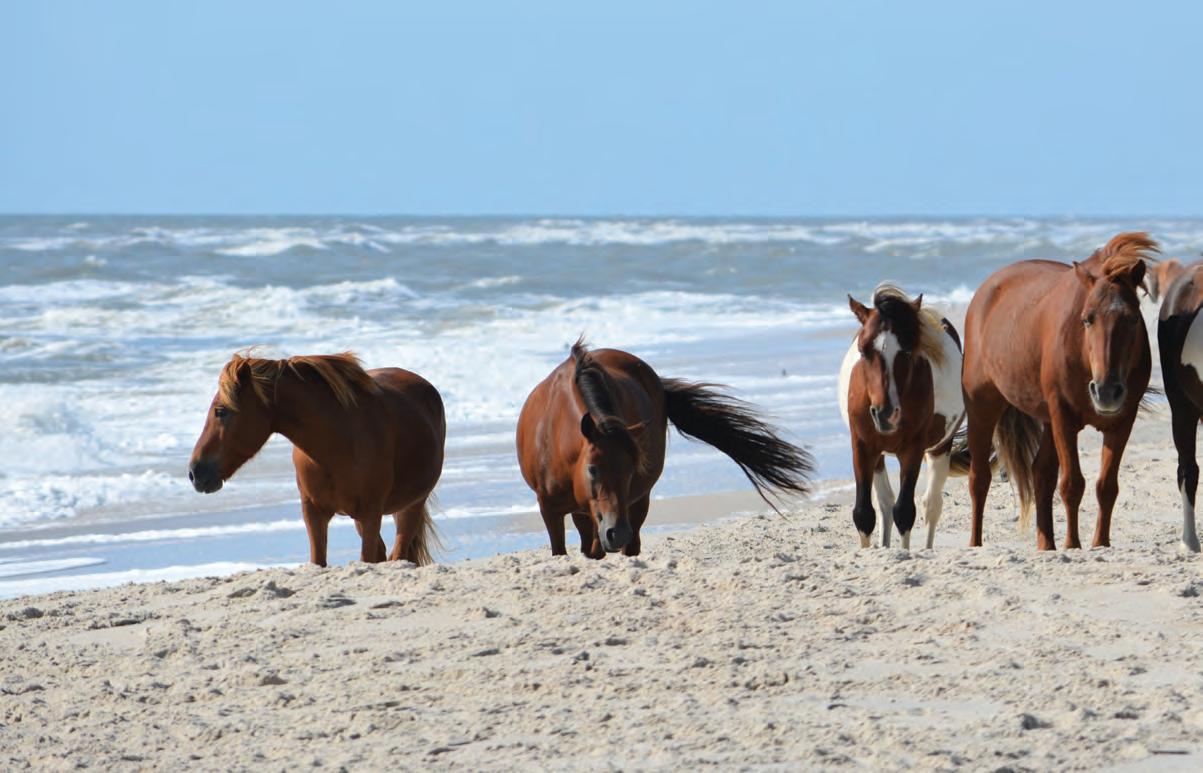
An abandoned Caribbean colony unearthed centuries after it had been forgotten and a case of mistaken identity in the archaeological record have conspired to rewrite the history of a barrier island off the Virginia and Maryland coasts.
These seemingly unrelated threads were woven together when Nicolas Delsol, a postdoctoral researcher at the Florida Museum of Natural History, set out to analyze ancient DNA recovered from cow bones found in archaeological sites. Delsol wanted to understand how cattle were domesticated in the Americas, and the genetic information preserved in centuries-old teeth held the answer. But they also held a surprise.
“It was a serendipitous finding,” he said. “I was sequencing mitochondrial DNA from fossil cow teeth for my Ph.D. and realized something was very different with one of the specimens when I analyzed the sequences.”
That’s because the specimen in question, a fragment of an adult molar, wasn’t a cow tooth at all but instead once belonged to a horse. According to a study published in the journal PLOS ONE , the DNA obtained from the tooth is also the oldest ever sequenced for a domesticated horse from the Americas.
The tooth was excavated from one of Spain’s first colonized settlements. Located on the island of Hispaniola, the town of
Puerto Real was established in 1507 and served for decades as the last port of call for ships sailing from the Caribbean. But rampant piracy and the rise of illegal trade in the 16th century forced the Spanish to consolidate their power elsewhere on the island, and in 1578, residents were ordered to evacuate Puerto Real. The abandoned town was destroyed the following year by Spanish officials.
The remnants of the once-bustling port were inadvertently rediscovered by a medical missionary named William Hodges in 1975. Archaeological excavations of the site led by Florida Museum distinguished research curator Kathleen Deagan were carried out between 1979 and 1990.
Horse fossils and associated artifacts are incredibly rare at Puerto Real and similar sites from the time period, but cow remains are a common find. According to Delsol, this skewed ratio is primarily due to the way Spanish colonialists valued their livestock.

“Horses were reserved for individuals of high status, and owning one was a sign of prestige,” he said. “There are full-page descriptions of horses in the documents that chronicle the arrival of [Hernán] Cortés in Mexico, demonstrating how important they were to the Spanish.”
In contrast, cows were used as a source of meat and leather, and their bones were regularly discarded in communal waste piles called middens. But one community’s trash is an archaeologist’s treasure, as the refuse from middens often confers the clearest glimpse into what people ate and how they lived.
The specimen’s biggest surprise wasn’t revealed until Delsol compared its DNA with that of modern horses from around the world. Given that the Spanish brought their horses from the Iberian Peninsula in southern Europe, he expected horses still living in that region would be the closest living relatives of the 500-year-old Puerto Real specimen.

Instead, Delsol found its next of kin over 1,000 miles north of Hispaniola, on the island of Assateague off the coast of Maryland and Virginia. Feral horses have roamed freely across the long stretch of barrier island for hundreds of years, but exactly how they got there has remained a mystery.
According to the National Park Service, which manages the northern half of Assateague, the likeliest explanation is that the horses were brought over in the 1600s by English colonists from the mainland in an attempt to evade livestock taxes and fencing laws. Others believe the feral herds descended from horses that survived the shipwreck of a Spanish galleon and swam to shore, a theory popularized in the 1947 children’s novel “Misty of Chincoteague.” The book was later adapted to film, helping spread the shipwreck legend to an even wider audience.
Until now, there has been little evidence to support either theory. Proponents of the shipwreck theory claim it would be unlikely that English colonists would lose track of valuable livestock,
while those in favor of an English origin of the herds point to the lack of sunken vessels nearby and the omission of feral horses in historical records of the region.
The results of the DNA analysis, however, unequivocally point to Spanish explorers as being the likeliest source of the horses on Assateague, Delsol explained.
“It’s not widely reported in the historical literature, but the Spanish were exploring this area of the mid-Atlantic pretty early on in the 16th century. The early colonial literature is often patchy and not completely thorough. Just because they don’t mention the horses doesn’t mean they weren’t there.”
The feral herds on Assateague weren’t the only horses to revert back to their wild heritage after arriving in the Americas. Colonists from all over Europe brought with them horses of various breeds and pedigrees, some of which bucked their bonds and escaped into the surrounding countryside.
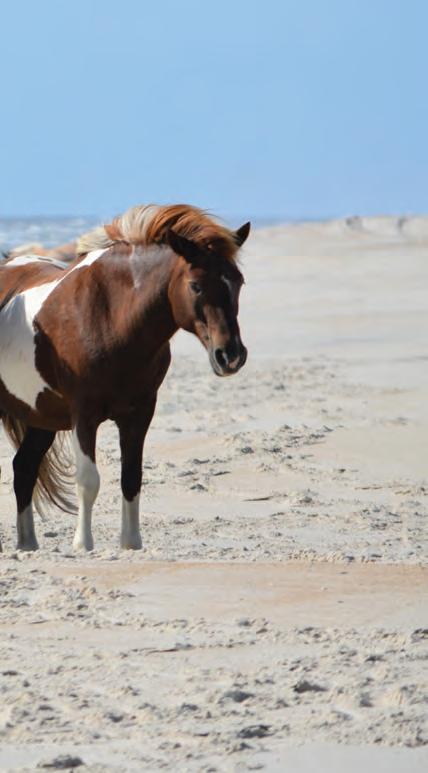
Today, the U.S. Bureau of Land Management estimates there are roughly 86,000 wild horses across the country, most of which are located in western states, such as Nevada and Utah. Delsol hopes that future ancient DNA studies will help decode the complex history of equine introductions and migrations that occurred over the last several centuries and offer a clearer understanding of today’s diversity of wild and domesticated horses.
The study was published in the journal PLOS ONE .
 by Alisson Cl Ark Photography by Brianne Lehan
by Alisson Cl Ark Photography by Brianne Lehan
Standing under the baking Arizona sun, Anita Marshall took a breath. Over the past week, she had overcome international travel disasters, technology struggles, wildfires, even interference from a pair of nesting eagles, to provide hands-on experience for aspiring scientists whose disabilities excluded them from traditional field courses. Now her students had assembled on the edge of a 400-foot crater outside Flagstaff, eager for what some had been told they’d never have.
Conferring with her team of instructors, Marshall, a University of Florida geologist, reboots the drone. A delegation convinces the men using the site for target practice to move to a different area. The marooned van will have to wait, because the 18 students — some here in the desert, some joining remotely — are keen to do some science.

The drone wouldn’t fly. The wheelchairaccessible van spun its tires, digging into the dusty gravel. And the men with shotguns refused to leave.
“They need this. If they don’t have experiences like this, we’ll lose some amazing minds out of our field,” Marshall says. “I don’t want that to happen.”
If you care about clean water, climate change, energy, sustainable agriculture or other areas that rely on earth scientists, neither should you, Marshall argues. But earth science degrees often require a physically taxing, six-week camping trip far from medical care and even electricity. It’s a deal breaker, not only for those with mobility limitations, but also chronic fatigue, digestive issues, even severe food allergies — not to mention family or work responsibilities that prevent them from disappearing into the wilderness for half the summer.
With a $440,149 grant from the National Science Foundation, she launched GeoSPACE, an accessible field camp that’s opening geosciences — the least diverse STEM field — to people who might not fit the mold of the mountain-scaling explorer conquering the wilderness.

That’s the very image that drew Marshall to the field, until a near-fatal accident changed her trajectory.
Now she wants to reimagine field camp from the ground up.
“I don’t want field camp to be a barrier,” she says. “I want it to be a springboard.”
The drone is finally cooperating.
“Fly my pretty, fly!” Marshall says, handing the controls to Francesca Butler, a geology student from the United Kingdom. Because Butler uses a wheelchair, she’s been excluded from fieldwork at her university. Butler says GeoSPACE’s summer 2022 pilot program has allowed her to feel “like a real geologist.”
“I was almost in tears when I was able to get out in the field for the first time,” she says. “I think this is going to be the blueprint for the future.”
After exploring the trails leading around and through the crater, Butler is getting a bird’s-eye view of an outcrop rippled with striations of red, brown and black that reveal the desert’s volcanic past. Drones are one way Marshall brings the
rocks to students. She also leverages satellite imagery, live high-definition video and the messaging platform Discord to put students in the middle of the action, whether they’re exploring the outcrop, working from a high-tech base camp beneath a pop-up awning, or joining remotely from home. After a half day at the site, they’ll return to a La Quinta in Flagstaff to review their data, learn about high-precision GPS mapping, and eat a home-cooked meal that accommodates all participants’ dietary needs.
It’s the opposite of a typical field camp, where forgoing comfort — and technology — is as much a part of the experience as the science.
But as Marshall is fond of saying, the rocks don’t care if you slept in a hotel.
“Chug your water, guys, that was a
Anita Marshalllot of dry air,” Marshall says from the driver’s seat on the way back from the field site.
The 15-passenger van rattles down a washboard road, every rut reverberating in bone-jarring judders. Pebbles ping the undercarriage like popcorn in a pan. Getting out of the classroom and into wild places like this is a cornerstone of field camp, and where research shows many students start to feel like real scientists. But for students with disabilities, who represent about 20% of the overall undergraduate population, it can also be an enormous source of stress. If they can’t get the accommodations they need to participate, they may have to change majors. That can lead students with less-visible disabilities to hide them, putting themselves in danger — a pattern
“I don’t want field camp to be a barrier. I want it to be a springboard.”
Marshall knows well from her own experience. With this trip, she’s setting out to prove that the rigor and the joy of field camp can come in an accessible package.

It took a year of planning and scouting to organize locations and logistics. Each site needs passable roads, wheelchairfriendly surfaces, strong cell service for streaming video, and proximity to accessible hotel rooms and bathrooms. If a site doesn’t offer a meaningful field experience for everyone on the trip, it doesn’t make the cut.
They also try not to spend more than half a day out in the elements, as their enthusiasm can tempt them to push
beyond their limits — another pattern Marshall knows well. Throughout undergraduate and most of grad school, she relished the physicality of her fieldworkheavy earth science program.
Then, on the night of her department’s awards banquet at the University of Arkansas, a drunk driver hit her as she was unloading her pickup truck. She nearly died at the scene and again at the hospital. When she regained consciousness, her left leg was crushed. So, she thought, were her dreams of becoming a field geologist.
“One of my very first thoughts when I woke up in the hospital was that my
geology career was over,” she says. “I had never heard of a geologist with a disability. I didn’t see any path forward.”
A year of reconstructive surgeries followed. Her father quit his job and moved closer to campus to help. He and her sister became her field assistants, gathering data from places Marshall couldn’t access. When insurance hurdles delayed getting a wheelchair, her grandfather offered his.
“He would get himself all comfy in his recliner and I would leave for school in his wheelchair, do my classes, and then come back and give him his wheelchair back. We knew the clock was ticking to finish
“This is going to be the blueprint for the future,” says University ofAberdeen student Francesca Butler, right,
shown learning GPS mapping with RutgersUniversity student Noam Aharon.
my master’s work. It was a big family push to get me through my degree.”
A member of the Choctaw Nation of Oklahoma, Marshall sees that community approach as central to her work in inclusion.
“Individualism is really foreign to a lot of indigenous viewpoints, and Choctaws are no different in that. You’re always looking out for the needs of your family and your group. That very much influences my philosophy on field courses,” she says. “Rocks are cool. People are better. Take care of your people, and the rest will come.”
After graduating, Marshall learned to walk again. She got a job teaching geology at a community college. She loved it, but the repetition was very different from the far-flung places and extreme environments she had imagined. For seven years, the same introductory geology class, the same National Geographic video about volcanoes. Then one semester, something about that video jumped out at her. One of the scientists, severely injured in an eruption, had resumed his research after a long recovery.
“He’s doing it,” she recalls thinking. “Maybe I can do it!”
She started applying to Ph.D. programs, got accepted, and a year later was headed back out in the field.
Things did not go smoothly.

On the rim of a volcano in Nicaragua, the doctoral students gathered for a lecture about the geological features around them — all but Marshall, left straining to hear from the other side of the crater. She had gone as far as her reconstructed leg and chronic fatigue allowed, farther, really, pushing beyond the point of safety, not wanting to be left behind. As the students walked past her on their way back, one rolled his eyes.
“I don’t know why she even bothers,” she heard him say.
She felt alone. But when she examined her situation like a scientist, she realized she couldn’t be. In student surveys, 22% of high schoolers with disabilities say they’re interested in STEM careers. By the time they’re in undergrad, just 10% are still pursuing STEM jobs. Among master’s students, it dwindles to 6%. Marshall clearly wasn’t the only one getting the message she didn’t belong.
“The more I dug, the more I realized
how little was being done and how this was a massive unspoken problem.”
Marshall knew she’d never regain the physical aptitude of able students. But with her new perspective, she started to wonder if the grueling physicality wasn’t central to the work, but merely the culture. Field camps have been slow to evolve, says Ellen Martin, UF’s geology department chair. As geosciences went high tech, field camp at many universities
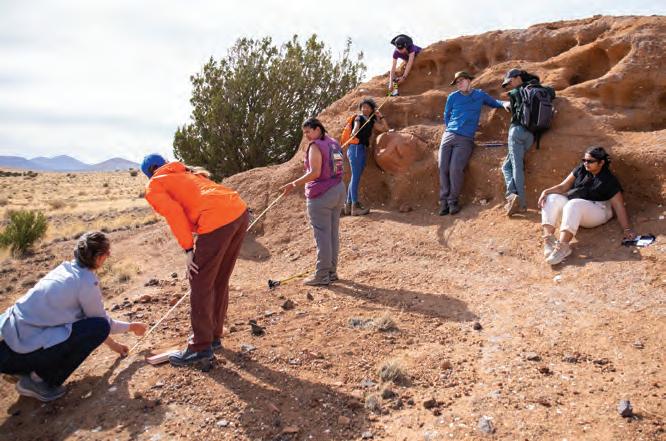
In student surveys, 22% of high schoolers with disabilities say they’re interested in STEM careers. By the time they’re in undergrad, just 10% are still pursuing STEM jobs. Among master’s students, it dwindles to 6%.
retained an emphasis on hand-drawn maps and physical prowess.
“There are instructors who try to make it as physically demanding as possible,” Martin says. “If that’s not the part of geology you’re going into, that’s not relevant at all.”
As a field geologist, Martin sees value in traditional field camps, but also recognizes that “we don’t all have to be men in flannel shirts with beards and rock
hammers running around in the woods. Finding a way to have a more diverse field camp gives options for people who are interested in other aspects of the science.”
Although not all geoscience careers require fieldwork, many geoscience degrees do — as do employers, who may look for field experience because of the pivotal role it plays in building students’ skills, confidence and networks.
The answer, Marshall realized, wasn’t to do away with field camp, but to recenter it on skills students actually need. Without that, talented young scientists would continue to leave the field.
“It makes me die a little inside when I meet these amazing students and realize that they are being shut out of our discipline,” she says. “They’re innovative. They’re creative. They’re resourceful. We’re actively pushing them out, and that just kills me.”
The National Science Foundation agreed, funding two years of GeoSPACE as part of its mission to reach those excluded when science careers aren’t accessible or inclusive. NSF Director Sethuraman Panchanathan calls them “the missing millions.”
“We are leaving tons of our talent behind,” Panchanathan said at a visit to UF in May.
“We need all of it to unleash innovation and prosperity for all.”
Programs like Marshall’s are important for student retention and a sense of belonging and acceptance in the field, says Brandon Jones, NSF Program Director for Geosciences Education and Broadening Participation programs.
“The GeoSPACE program is using creative approaches to ensure that people with disabilities can participate fully and meaningfully in field experiences,” Jones says. “GeoSPACE involves students in developing the field experience and creates a network of mentors to support and encourage them.”
At the crater, teams of students fan out across the landscape, tackling the research questions they designed with the remote students. A remote option was critical to be truly inclusive, Marshall says, as some students’ disabilities won’t allow them to participate even with accommodations.
The virtual participants serve as mission control for the group, introducing each new site based on satellite data, thermal imagery and Google Earth. In-person

students act as the astronauts exploring the surface of another planet, gathering data that requires closer observation. It’s an apt analogy for this otherworldly landscape, and relevant to the course’s focus on planetary geology. But at its core, it’s a strategy to ensure everyone, regardless of their level of physical participation, has an integral part in the mission.
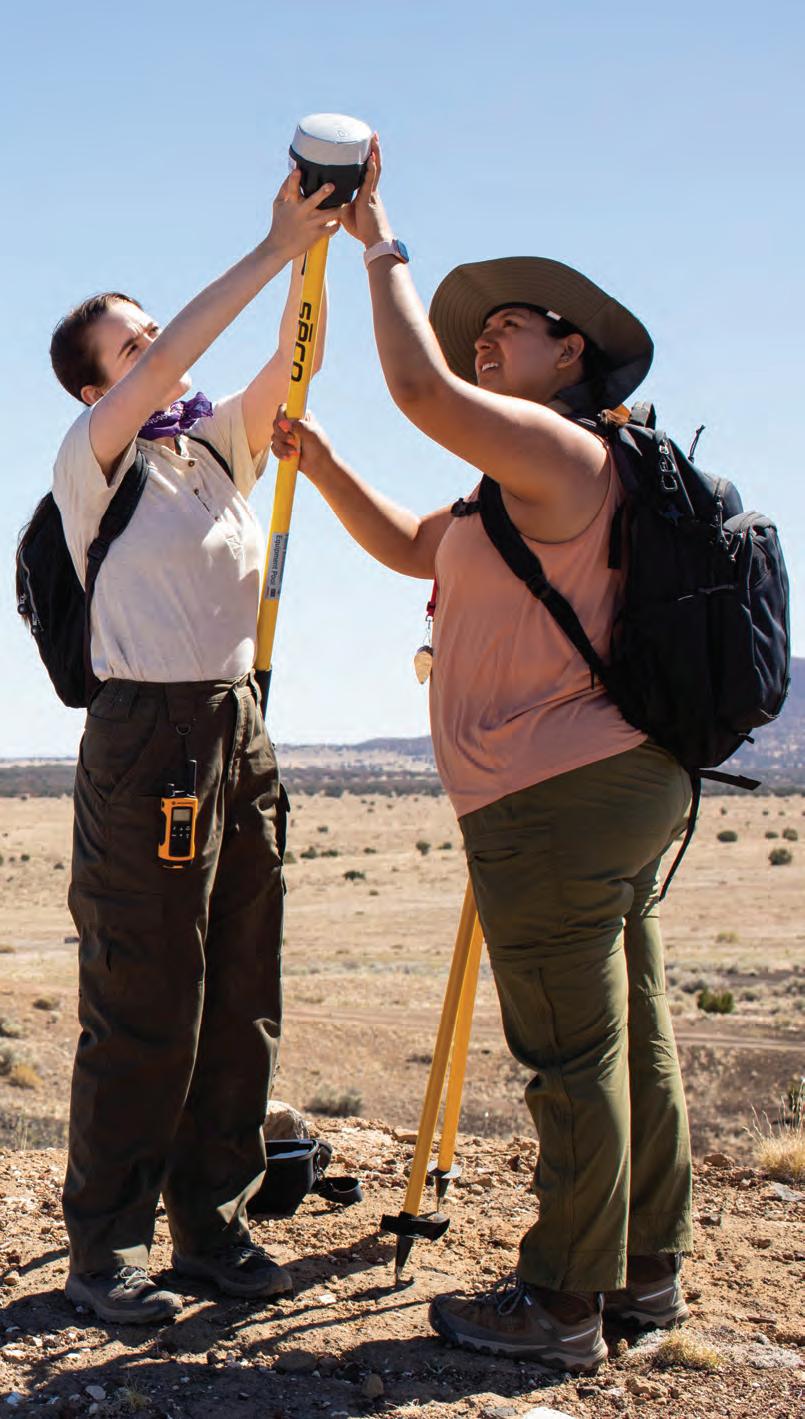
“I know that feeling of being left at the van while everyone else goes to do cool stuff,” Marshall says. “I don’t want another student to feel like I felt.”
Rutgers student Shivani Dattani returns from a sun-scorched ridge flanking the crater, taking a moment in the shade of the van to reflect on getting her first field experience through GeoSPACE. After a personal trauma, Dattani struggled to regain her footing in academia.

“This has really helped me bridge that disconnect from the year I missed,” she says. “It’s easing me back into what I really want to be doing: academic research. I feel like there might be a space for me in the scientific community.”
After receiving more than 70 applications from around the United States and six countries, Marshall realized how many types of students also felt like outsiders.
“Not everyone in our group identifies as disabled. They come from many walks of life, many different identities, and they all feel traditional field camp is not a great place for them.”
Marshall’s goal of broadening access resonated with UF geology graduate and GeoSPACE project manager Yesenia Arroyo, who joined the team which includes UF professors Steve Elardo and Amy Williams, plus geologists from Arizona State University, Central Connecticut State University, the University of Cambridge, the U.K.’s Open University and Rutgers University.

“What she was saying about accessibility really struck a chord with me as a geologist with various intersectionalities myself,” says Arroyo, who is Black and Hispanic. “She definitely has the mission to get geologists of all shapes and sizes out here. It shouldn’t be stopping you from participating in something you love.”
Unfortunately, not everyone agrees.
In 2018, her Ph.D. complete, Marshall started looking for a faculty job. Wrapping up her presentation on inclusive fieldwork at one interview, she asked if there were any questions.
After a long silence, one professor raised his hand and asked, “Why? Why bother?”
While most people don’t say it out loud, plenty share his assumption that disabilities impact a tiny portion of geoscience students. Because many disabilities aren’t outwardly visible, faculty members might assume no one needs accommodations. Sometimes they’re right, because those who do have concluded that they’re not welcome and changed majors. When students request accommodations for fieldwork, they often face resistance, Marshall says. As executive director of the International Association for Geoscience Diversity, she hears these stories constantly from universities in the United States and beyond. For example, one student whose manual dexterity limitations made it hard to take notes asked to use a tablet in the field. The request was denied.
Beyond disability, students with young children, financial constraints, or mental health considerations can see a traditional field course as an insurmountable obstacle. Try asking your boss for six weeks off, then paying for the course while you’re not working, she says.
“It really was designed for students from a bygone era — mostly male, independent students who had the financial and social ability to disappear for six weeks. For modern students, it’s increasingly hard to do that. The financial barrier is huge. The time barrier is huge. And six weeks is a long time to go without your support network. To make that a required component to finish a degree seems like a pretty large request.”
Back at the hotel, the group gathers for a taco buffet in the lobby, still buzzing about their day in the field.
“Don’t get used to this,” Marshall laughs, referring to the allergen-safe food, the laundry facilities, the comfy beds.
She knows many of these students will go back to programs that require more than she can provide. GeoSPACE puts the all-important field experience on their resume, but as a two-credit course, it can’t replace the typical six-credit requirement on its own. At UF, students can replace the traditional course with another option approved by the undergraduate coordinator. An injured student was able to fulfill the entire 6-credit requirement virtually, an option geology chair Martin says is available to others who need it. But few universities offer such alternatives, which worries Marshall.
“I don’t want to take them out to have this amazing experience, get this little glimpse of how things could be, and then kick them back to the real world where they still can’t get through their degree programs,” she says. “That would almost be a cruel joke.”
Instead, Marshall wants other universities to use GeoSPACE as a model, leveraging everything she’s learned to develop inclusive, accessible two-credit modules on different topics. UF is considering adding a two-credit option during spring break, Martin says.
“I’m amazed by the impact Anita’s already had,” she says. “It’s making a lot of people think. I suspect a lot of places will realize it’s to their benefit to offer programs like that for their students.”
If they do, we all stand to benefit.
“We can’t keep courting such a narrow sliver of humanity and then expect to tackle these big, complex problems that affect everybody,” Marshall says. “We have to move forward with all the voices. And not just for the science, but because it’s the right thing to do.”
Anita Marshall Lecturer, Geological Sciences anita.marshall@ufl.edu
Scan to view or share this story with digital extras.


Where, when and how we work may never return to pre-pandemic norms. Artificial intelligence and demographic shifts will reshape our careers. And we’ll need to tend to ourselves and each other to ward off burnout and grow as workers and leaders. That’s what we heard when we asked for advice and predictions from University of Florida management faculty — the country’s top management department in publications per capita in a 2021 Texas A&M/University of Georgia research productivity ranking.
The faculty’s shift toward envisioning the long-term impact of pandemic-era disruptions is a natural extension of their research, says Warrington College of Business Dean Saby Mitra, who calls their work “very applicable to people’s daily lives.”
I f you left your company in the Great Resignation and you’re wishing you could undo your decision, maybe you can, says Brian Swider, one of a handful of experts worldwide studying “boomerang employees” who leave and return to the same company.
Before you approach your old organization, think about how you’ve changed since you left. What relevant experience did you gain?
“External hires will have a similar pitch about their knowledge, skills and abilities, but the boomerang employee can say, ‘Here’s how I would apply it,’” he says.
Highlight how you can hit the ground running: Returning employees can save their employer up to 66% in onboarding costs due to the lower amount of training required and their ability to reach full productivity faster, Swider says.

When Swider brings up returning employees in his executive classes, one concern always emerges: “They think hiring back an old employee would tell other employees they can leave without consequence.”
He hasn’t seen any evidence to support increased turnover, however. In fact, hiring boomerangs can boost job attitudes for the returning employee and their co-workers, he says. When proven performers want to return, bear in mind that you know more about their skills and how they fit into the culture than any external candidate. Along with the streamlined onboarding and a quicker path to full productivity, boomerang candidates can
Brian Swideralso create a larger applicant pool, which increases the likelihood of a successful hire, Swider says.
That said, not all boomerangs are worth rehiring. Swider’s 2017 study in the Journal of Applied Psychology showed that top performers and employees with shorter time outside of the company were more likely to be successful upon return.
“Put your pride aside,” he says. “If you have a dossier of people who you know are great performers and you’re willfully choosing not to reach out to them, that seems like a suboptimal decision.”
As offices return to pre-pandemic routines, Joyce Bono expects to see lasting changes in workers’ expectations. After 42 hours of interviews with dual-career couples for a forthcoming study, she predicts that employees will want to keep the flexibility to toggle between family and work demands.

Resigning gracefully makes an eventual return less awkward, but employers should smoothe the separation as well.
“Companies are starting to focus on the offboarding process as much as onboarding,” Swider says.
What workers say in exit interviews can be useful later to woo back top performers. Some companies recruit boomerangs proactively, creating alumni groups on LinkedIn and having mixers for former employees.
“You can reach out to that person to see, was the job you left for really all that you expected? Are there things that we could do or things we have changed that address the concerns you expressed?” Swider says.
Returning to a former employer might seem awkward, but research indicates the opposite.
“What we find is that the returners typically are going to be more satisfied and have a better appreciation for the job. They also recognize that their organization cares about them. Those two factors make boomerang employment a worthwhile proposition for both parties.” ✺
A: People — mostly mothers — have been complaining forever that they can’t get their kids off to school in the morning or pick them up after school. But now it’s fathers’ voices joining, saying, ‘Even if I have to go to the office every day, why do I have to be there at eight o’clock because somebody decides that’s my start time? Why can’t I work from six to eight in the morning, take my kids to school and then show up at the office?’ This is not just about people with children. We’re seeing the same thing with childless people or people whose kids have left the house saying, ‘my work can’t have all of me.’
A: Trust. As a manager, you will need to have relationships with your employees that are trustworthy enough that when you don’t see them, you believe they’re working. You need a way to set some kind of parameters and communication so that when I’m working at home, you’re not pinging me with emails just to see if I’m responding. What that’s going to require of employers is to think more about results. If the results aren’t there, then rather than micromanage you, I train you. I mentor you. If the results still don’t happen, then this isn’t the best relationship.
A: Best Buy tried a results-only work environment where you could work from anywhere, and within the first few months, something like 30% of the people wanted to go back to the office. They needed the structure. They wanted separation between work and life. So that’s one thing we should acknowledge — it isn’t for everyone.
More organizations will re-evaluate the work week. “You will continue seeing more non-
9-to-5 arrangements,” says Brian Swider. That could mean a compressed work week or flextime with blocks when all staff are available.
Q: When you asked dual-career parents how the pandemic changed their outlook on work and family, what did you find?
will say,
‘You can’t have all of me’
A: Historically, these issues have led women to drop to second-class careers. So they’re going to get all this female talent that they haven’t been able to get. They’re going to keep their best employees, because the people who can leave for another job are actually your very best ones. Your people are going to be happier and healthier. Will it make more money for you? No, but it also shouldn’t have to reduce your profits. If your corporation is trying to suck dry everything you can from every employee, if you think of them as a resource to be used up, this will not work for you.
Workers will seek a higher purpose in their work and guide their careers
accordingly. “More people will do work that is important versus work that pays well,” says Joyce Bono. “Meaningfulness matters more.”

A: ‘You can’t have all of me’ doesn’t mean I have to have balance every day. There are many ways to achieve balance. We could look at the notion of a sabbatical for people like nurses to be able to renew with a longer break from work.

A: For all the speaking we do about family first, our society says our devotion to work comes higher. One of my executive MBA students was taking a vacation with her husband, and they couldn’t do a bike trip they wanted to do because there was no cell phone service and he had to be reachable by his company. That’s got to change, and it’s going to help if key valued employees start asserting it. When executive employees, especially men, say ‘I’m leaving today at three o’clock because my child’s in a play, and I’m going to work at home tomorrow’ — those first steps are valued. ✺
Joyce Bono Ben SimonsY ou might think being constantly connected to work helps you stay ahead. You’re wrong, says researcher Brian Swider. Although it may feel productive to mind your inbox when you’re off the clock, separation actually makes you a better worker.
“The drawbacks to staying attached in terms of your stress, your cognitive functioning and your physiological wellbeing will offset any sort of benefits you think you’re going to get,” Swider says.
In an analysis of 25 studies of more than 6,000 employees, Swider identified burnout as a top predictor of turnover, accounting for about 11% of turnover and 13% of job performance. To fight burnout, make the most of the time you call your own by focusing on the components that research shows contribute to recovery. Three are relatively obvious: psychological detachment from work, relaxation, and control over how you spend your time. The fourth is less expected: mastery.
Mastery sounds taxing, but it doesn’t have to be, Swider says. You don’t have to perfect sourdough or learn an instrument to recover from work stress. Swider likes a streaming binge as much as the rest of us, but he likes to plan his movie lineup and contextualize what he watches as part of a deeper experience.
The activities that check those boxes will be different from person to person, but keeping those parameters in mind can help you find what works for you, Swider says — especially if you have difficulty separating from work during off hours.
“Taking a more effortful approach and being more planful about what you’re going to do can ensure that you are taking the steps to maximize the rejuvenative elements of recovery.” ✺
We asked researcher Klodiana Lanaj how showing kindness to yourself can make you a better worker. Here’s what she had to say.

ork has gotten more challenging during the last few years as we have dealt with the uncertainty of our jobs, health, and the future of the world. The silver lining in all this is that we are — to a certain degree — going through these hardships together as a society. These shared experiences enable us to understand and to empathize with those among us who are struggling to be productive or to remain hopeful. One piece of advice that emerges from my research is that we all need compassion to navigate the challenges of daily life at work, and in particular, we all need self-compassion.
Self-compassion happens when we treat ourselves as we would treat a good friend who is going through a hard time. Often, we are harsher on ourselves than on our friends: Remember that time when you made a mistake at work and beat yourself up about it for days on end? Chances are that if a close friend made a similar mistake, you would empathize and encourage them gently to move on and to learn from the situation rather than dwell on it. We all deserve this same treatment when we make mistakes or face hardships.
In some of our research, my colleagues and I find that when employees take a few moments of their day to think about work challenges with a mindset of self-compassion, they feel more energized, more optimistic about their capabilities at work, consequently performing better, and feeling more resilient. We find similar effects among leaders — when they approach leadership challenges with a mindset of self-compassion, reminding themselves that their struggles are part of being a leader, they help others more at work, and are seen as more effective and kinder by their coworkers too. ✺
 Klodiana Lanaj
Klodiana Lanaj
Spurred by longer life spans, lack of savings and an aging of the population, “we’re going to see larger age diversity in the workforce,” says Mo Wang, whose research focuses on older workers. “We’ll see peer mentoring between younger workers and older workers to leverage different kinds of knowledge, because both sides have good expertise.”

With artificial intelligence taking a larger role in screening job applicants, Mo Wang whose research in equitable AI-assisted hiring is supported by a nearly $1 million grant from the National Science Foundation and Amazon — offers these tips.

Avatars are people too: For jobs with a large applicant pool, your first round of interviews might be with an avatar instead of a human. Job seekers should dress, act and answer as if the avatar or recorded interviewer were a live person, Wang says. Always assume a human will review the audio and video recording of the interview.
Get to know O*NET: Technology might sift through applicants’ resumes before they reach a human, so relying on your cover letter to wow a manager might not work. To help your resume make the cut, Wang suggests searching the U.S. Department of Labor’s O*Net website (onetonline.org). O*Net offers a ranked list of skills for more than 900 occupations to help prioritize keywords to include and experience to emphasize.
Never fully rely on AI: For employers, it’s important to know that while AI can speed the screening process, humans should review the hiring system’s decision-making to ensure fairness, Wang says. Organizations that unwittingly allow bias to seep in from flawed technology may miss out on top talent and face legal consequences down the road. ✺
Mo Wang Ben Simons Ben Simons



University of Florida history Professor Jack E. Davis has made a career out of writing about big environmental topics. He won the Pulitzer Prize in history for his 2017 book The Gulf: The Making of an American Sea, and now he’s got a new book out titled The Bald Eagle: The Improbable Journey of America’s Bird.
Among the many interesting facts about the rise and fall and rise again of the bald eagle that Davis describes are several about the role Floridians, and University of Florida scientists in particular, played in bringing the bird back from the brink of extinction.
Here are some excerpts Davis chose to summarize the nation’s history with the bald eagle and UF’s role in saving it.
The bald eagle has been associated with higher principles and better attributes since 1782, when Congress made it the central figure on the Great Seal of the United States. Representing fidelity, self-reliance, strength, and courage, the founding bird quickly attained a vaunted perch in America’s iconography. Its visage appeared on the U.S. Capitol dome and pediments, hard and paper currency, business and sports-team logos, coat buttons and cuff links, and the 101st Airborne’s sleeve patch ...
Yet no animal in American history, certainly no avian one, has to the same extreme been the simultaneous object of reverence and recrimination. For centuries, eagles risked their lives flying across American skies. People familiar with the history of the bald eagle generally know that in the mid-twentieth century, DDT nearly eliminated the species in the contiguous U.S. Fewer know that before then the bald eagle’s existence was gravely threatened by something as equally toxic as that lethal chemical pesticide: myths, lies, and insensitivity. False accusations [of livestock pilfering and baby kidnapping] fostered a cross-eyed vision of a morally depraved predator and thief
For more than a century before DDT’s commercial introduction, Americans prosecuted a fierce coast-to-coast assault directly against their flagship bird. The aggression was nothing short
of premeditated and acceptable legally and socially. Anyone anywhere in the position to do so squeezed the trigger and carried out the bird’s execution respectable, hardworking, churchgoing people who thought they were doing no more harm than pulling up an annoying dandelion ...
All this is to say that twice, not once, the United States nearly lost its flagship bird from the wild, and twice people aided its return. The first time, the Bald Eagle Protection Act of 1940 sought to stop the century-long bloodshed and establish a peaceful accord between Americans and the persecuted species.
The bill had previously failed in Congress after experts testified that bald eagles were nonmigratory birds, arguing that federal protection would encroach on a state’s authority over resident birds. The individual who brought new light to bald eagle migration was Charles Broley, a blue-eyed Canadian banker who retired to Florida. Broley began banding eagle nestlings in the 1930s, when no one was duplicating his efforts elsewhere. The following passage describes his first climb up a nesting tree. He climbed over 1,100 trees over the next 20 years to prove that bald eagles migrate across state and national boundary lines.
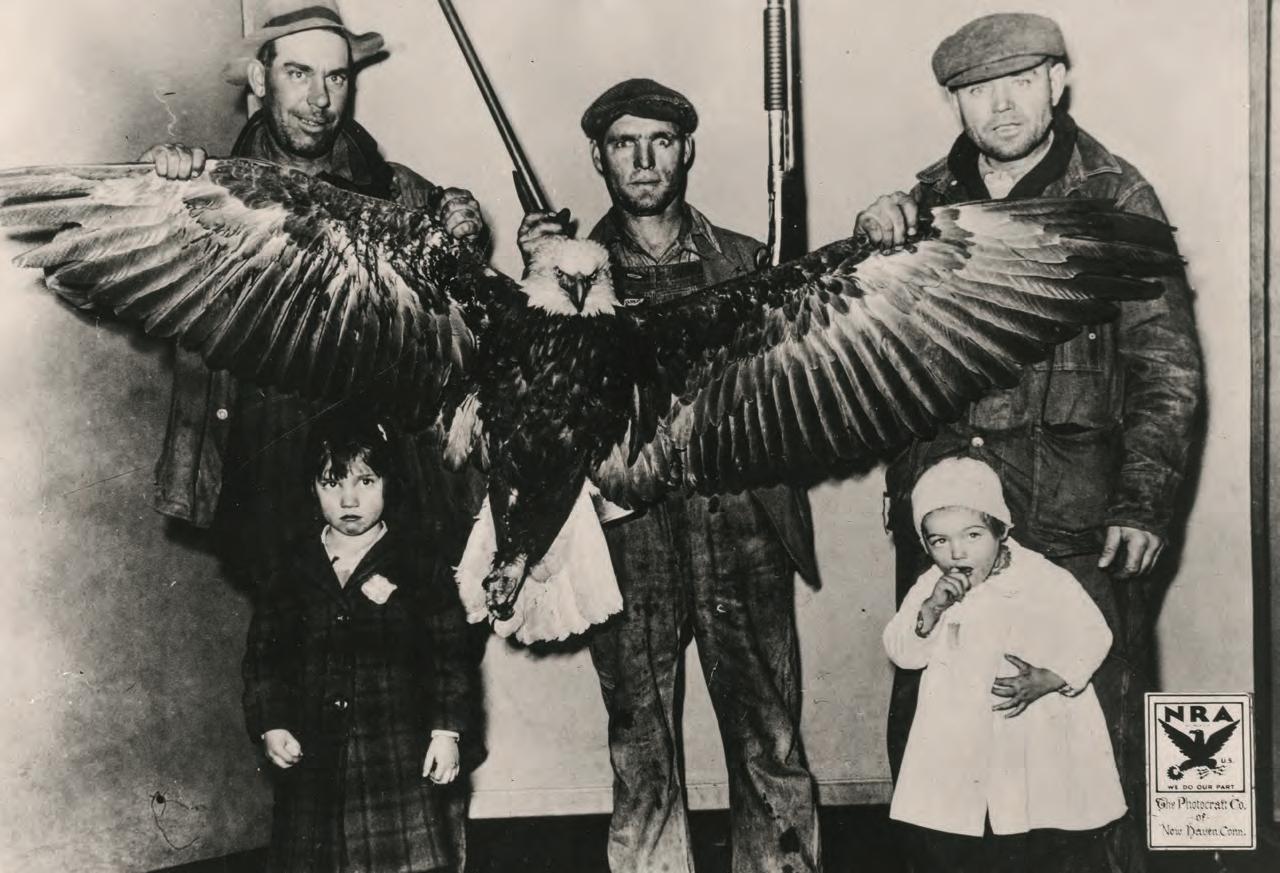
Aloft in the eyrie, safe at home, were two young bald eagles. Five or more pounds each, physically the size of a rugby ball, they were nearly ready to experience the brilliance of flight. Their eyes were dark, their feathers too. The spiky ones on their heads drew back as if a stiff wind were perpetually blowing in their faces. Their legs, feet, and beaks were leather colored, their talons black and long. They were alone together in the nest and safe. At five to six weeks, eaglets are typically left unattended while their parents are off fishing or hunting, giving the young room to romp and exercise. By then, they are too big to be preyed upon by an owl or a hawk, and they have their talons, four on each foot eight lethal pirate hooks. Eaglets growing into juveniles are to be avoided, not accosted.
Yet there are always violations of what’s expected, such as when an odd, unfamiliar creature appeared at the edge of the two eaglets’ security ... Its intense blue eyes fixed on the young birds. They backed away to the far side of the nest, beaks open, narrow tongues protruding, hissing. The smaller of the two balanced clumsily at the edge. The odd figure, about to become an unquestionable threat, stretched forward and reached for the teetering eaglet. It jumped. The falling youth instinctively opened its wings and, slack on the air, glided safely into a clump of saw palmettos.

The blue eyes then turned on the other eaglet and reached out again. The eaglet sensed a grip around one of its wings and, fighting back, drew blood but could not free itself. It felt something around one of its feet, small and metallic, clamping but not restraining. The intruder let go, and the frightened bird scrambled back and away, watching as the blue eyes dropped back below the nest.
On the ground, the intruder crashed through stiff, green fronds of saw palmettos, where the second eaglet was hiding Danger pushed closer. The grounded bird panted. Fronds opened, and sunlight and the blue eyes fell on the eaglet. It scrambled off, flapping its wings, using them as weapons. The pursuer persisted. The bird was seized, its wings and legs arrested. As with its sibling, something metallic went around one of its feet, but this eaglet was not set free.
A soft cover fell over its head of spiky feathers, and all went dark. For a long period the eaglet was in a blinded, free-floating space, tugged about at times, swaying at others. Finally, light appeared as the cover was lifted off. The eaglet was back in the nest. Its dark eyes found its sibling, and it clambered over and away from the intruder, watching the strange being slip down and out of sight.
By 1959, when Broley was 79 and had climbed his last tree, he had banded 1,240 eaglets. That number would have been much larger if not for DDT, which went on the commercial market in 1945. Banding eaglets made him witness to the species’ precipitous population decline, and he was one of the first to link the pesticide with bald eagle mortality. Rachel Carson noted his work in Silent Spring. A year after its 1962 publication, the eagle population fell to fewer than 500 nesting pairs in the lower 48 states, and in 1972 the EPA banned the domestic sale of DDT. Subsequently, University of Florida scientists, in collaboration with the George Miksch Sutton Avian Research Center in Oklahoma, launched an egg translocation program using Florida eagles to repopulate southern states ravaged by DDT.

Nobody had ever pursued this approach [egg translocation] with eagles, and understandably, it had skeptics T he central question was whether the Florida breeders would produce a fertile second clutch of eggs after researchers took the first from their nests. Despite apprehensions, everyone agreed to give [the] plan a try. Mike Collopy, who was head of wildlife and range science at the University of Florida, and a self-confessed doubter, collected eighteen eggs from Florida eagle nests in December 1984. The eggs successfully hatched at Sutton. At eight weeks old, the unfledged juveniles were relocated to hack sites [large elevated outdoor cages] in Oklahoma and two other states, and after they fledged, they took off to carry on life in those states. The Florida eagles that had unwittingly donated eggs indeed double-clutched, and their new eggs hatched. This exciting development convinced everyone that such “egg-recycling” was possible.


At the start of the next season, Petra Wood, a graduate student who worked with Collopy, conducted a weekly aerial reconnaissance of fifty to sixty nests in north-central Florida Wood flew with Florida Game pilots, surveilling the piney backwoods of a six-county area in north-central Florida. Unlike other parts of Florida, not much below the plane had changed since William Bartram had traveled through the area two
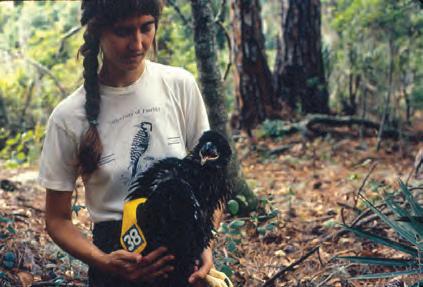
centuries earlier and complained about the thieving ways of bald eagles. In the 1920s, Marjorie Kinnan Rawlings made a home in the region at Cross Creek, and set many of her stories and books in the rural hinterland R awlings described the bald’s eyrie ungraciously as a “ragged cluster of sticks in a tall tree.” Yet of the hamlet of Cross Creek, she said, “There is no magic here except the eagles.”
Ace fliers, the pilots would circle one of those ragged clusters of sticks while keeping the nose of the Cessna pointed on it. Wood, trying to keep her last meal down, would look for eggs and the practicality of access for a ground crew, which would include a climber and a small contingent from the Sutton Center. The tree jock would strap on climbing spurs and ascend each host tree. The vibration referring up the trunk from his spurs daggering into the bark and sapwood was usually enough of a fright to flush the sitting parent. Upon reaching the nest, the climber would put on a surgical mask and gloves to prevent contamination and carefully place the eggs in a padded cylinder cinched to a long rope. “Eagles pick the most majestic views in the world,” one intrepid tree jock told a writer for Life magazine. “Up there, surrounded by the wind, a sense of awe comes over me. I feel like I should recite some sacred incantation.”
Someone might have been reciting one for getting the eggs to Oklahoma. Transporting them nearly thirteen hundred miles was a risky undertaking. The Sutton team had come down in a motor home and driven the twenty-plus-hour return trip straight through. Rotating duties, one person would drive, another would sleep, and the third would sit with a pillow on their lap with the incubator on top. The eggs were kept at 99.5 degrees Fahrenheit, with no more than a half-degree deviation. Every three hours an alarm would ding to remind the team to turn the eggs, as do the parents, to keep the embryos from sticking to the inside of the shell.
When eggs arrived at Sutton, those with thin shells stayed in an artificial incubator. Others were placed underneath Cochin hens T hey are accomplished sitters. Still, a shell would occasionally crack, and the staff would rush in like all the king’s horses and all the king’s men with superglue and mend the egg Incubation ran approximately thirty-six days, and hatching took approximately thirty-six hours ...
Starting out at three to four ounces, chicks reached about five pounds in four weeks ... [Caretakers] screened themselves from the eaglets and fed them using a hand puppet with a latex eagle head and black sleeve. The eaglets ate well, sumptuously treated to a

mixed diet of Japanese quail, rabbits, lab rats, and roadkill deer. In their eight-week stay at Sutton, each consumed the equivalent of eight hundred quail ... At about eight weeks of age, when their dark-brown juvenile feathers were grown in, the eaglets were moved to hack sites in one or more of five states: Oklahoma, Alabama, Georgia, North Carolina, and Mississippi.
Today, the lineage of many nesting bald eagles in these states can be traced to Florida birds. Over a seven-year period, they contributed 275 eggs to science. Thanks to restoration programs across the country, and the species’ evolutionary instinct for selfpreservation, the bald eagle population now stands at approximately 500,000 across the continent, the estimated number that existed when Europeans first settled North America.
 Jack E. Davis Professor of History davisjac@ufl.edu
Jack E. Davis Professor of History davisjac@ufl.edu

astronomy Professor Rafael Guzmán has spent his life looking up at the stars, but it took just one question in the spring of 2011 to shift his focus 180 degrees and send his career into a whole new orbit.
Cristina Garmendia, the Spanish Minister of Science and Innovation, was visiting the Kennedy Space Center to view the launch of a European Space Agency physics experiment to the International Space Station, but the launch was delayed for 24
hours. So a quick visit to UF was arranged, with Guzmán, a Spanish native, leading the tour.
Guzmán mentioned he was working with Spanish astronomers, mounting telescopes on small satellites to search for dark matter, when Garmendia asked the pivotal question.
“This is very interesting, Rafael,” Guzmán recalls Garmendia saying, “but have you ever thought about using the same technology to look down at the Earth?”
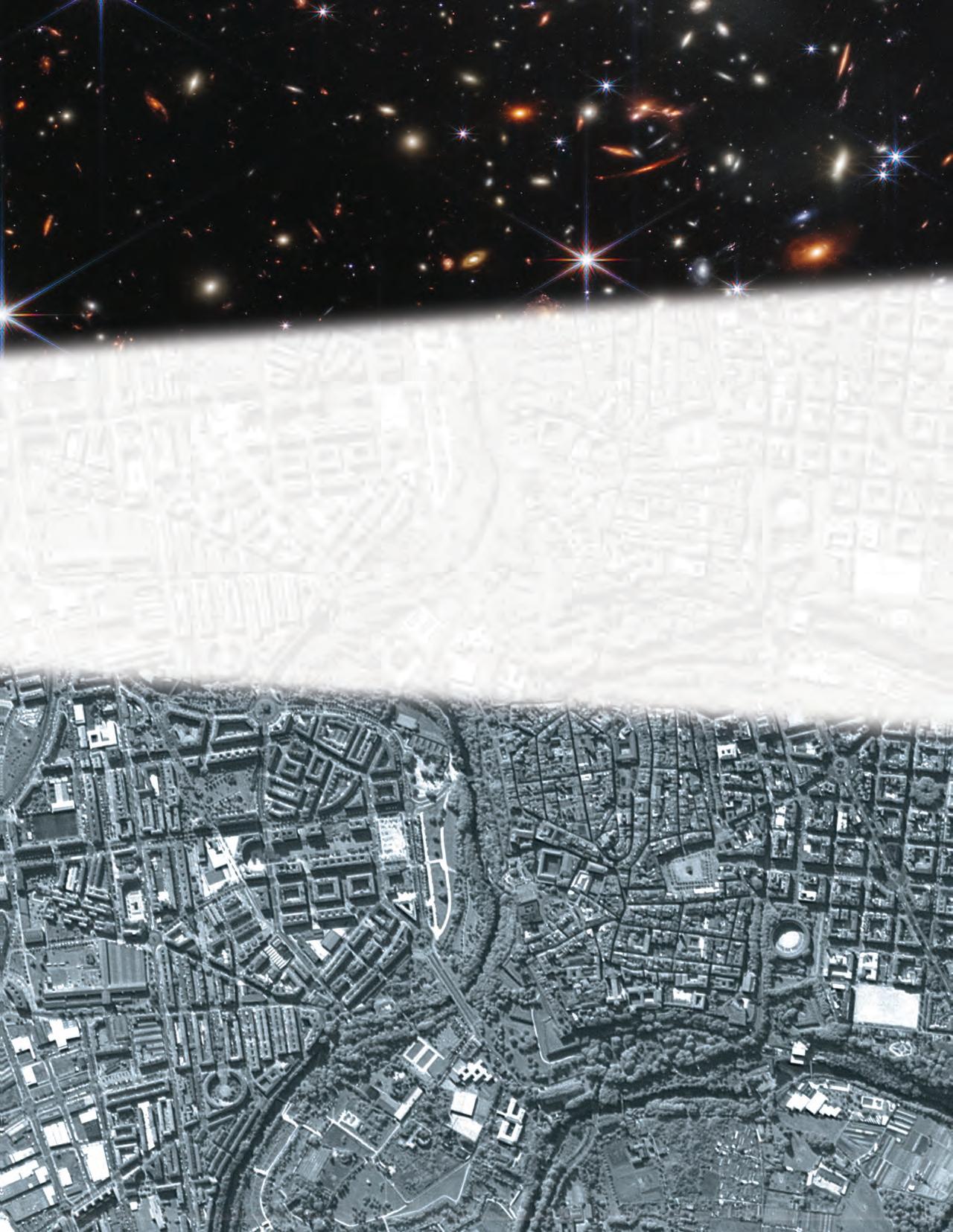 UF spinoff Satlantis is leveraging deep-space astronomy technology to provide solutions on Earth
UF spinoff Satlantis is leveraging deep-space astronomy technology to provide solutions on Earth
Flight model of the iSIM-170 (“integrated Standard Imager for Microsatellites”) binocular camera in the Satlantis laboratory. This is the camera launched by the Japanese Space Agency to the International Space Station (ISS) in May 2020.

Guzmán focuses on galaxy evolution using both ground- and space-based telescopes, but he admits he had never really thought about looking back at Earth.
“Typically, astronomy uses very different observational techniques than Earth observation,” Guzmán says, “but it turns out that our way of observing the universe actually offers a very competitive set of applications when looking down at Earth.”
The small satellite telescope Guzmán’s team was designing seemed to provide an ideal platform for Earth observation. It could provide as good or better resolution than one 10 times its size. And in space research, size equals money.
The smallsat telescope got its start in 2009, when, as chair of UF’s astronomy department, Guzmán was part of a contingent that traveled to the Canary Islands for the dedication of the Gran Telescopio Canarias (GTC), the largest optical telescope on Earth. UF is the only university partner on the GTC and built a $3 million infrared camera that became the first GTC instrument.
While there, Guzmán and Jaime Denis, director of the Instituto Nacional de Técnica Aeroespacial (INTA), Spain’s equivalent of NASA, began talking about opportunities to collaborate on small satellites, an area into which Spain had recently ventured.
“INTA had recently launched two small satellites, but it was purely an
engineering exercise, with no scientific instrumentation,” Guzmán says. “We were building instruments for ground-based observatories, so I suggested we could partner with INTA. They could build the satellites and we could build the instruments, thanks to the expertise in astronomical instrumentation developed at the Department of Astronomy for groundbased observatories.”
Negotiations ensued and a few months later Denis came to UF to sign a memorandum of understanding for the two entities to collaborate.
The researchers decided to concentrate on building a simple telescope to explore “dark matter,” which is thought to account for 85% of the matter in the universe, but is difficult to detect by traditional means because it does not appear to absorb, reflect or emit electromagnetic radiation, like light.
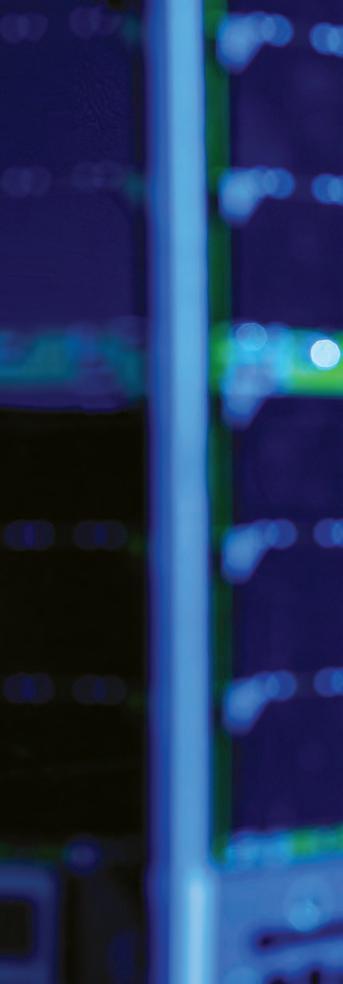
“Although we cannot see dark matter directly, we theorize that it affects the properties of satellite galaxies within the dark matter halos around large galaxies like the Milky Way that we can observe,” Guzmán says. “But observing these effects is very difficult from the ground because these satellites have very, very low surface brightness. They are about 10,000 times fainter than the darkest part of the night sky.”
By the time Garmendia visited UF in 2011, UF astronomy engineers were deep into the design of the smallsat telescope.
With Garmendia leading the way, UF, the State of Florida and the Spanish government developed a plan for a $10 million collaboration to develop small satellite telescopes to look for dark matter, and to conduct Earth observations.
“Then there were elections in Spain, Garmendia left her post, and this was not a priority of the new government,” Guzmán says with a shrug, so the project stalled.
But Garmendia, now back in the private sector, hadn’t forgotten about the project. In 2013 she proposed forming a company to pursue the idea, and Satlantis was born as a UF spinoff.
Over the next several years with support from UF Research, the Florida Space Research Institute (now Space Florida),
“Typically, astronomy uses very different observational techniques than Earth observation, but it turns out that our way of observing the universe actually offers a very competitive set of applications when looking down at Earth.”
— Rafael GuzmánJohn Jernigan
and the Florida High Tech Corridor Council Guzmán and the Satlantis team based at UF Innovate’s The Hub in downtown Gainesville worked with astronomy department engineers on the new telescope.
Guzmán says they ended up with a binocular telescope because that allowed simultaneous observation in both the visible and infrared wavelengths with no moving parts.
“We designed an extremely simple camera, with extremely good performance,” Guzmán says, “but we had to prove it could maintain that performance through the vibration of the launch and in the extremely tough environmental conditions in orbit.”
The first two prototypes demonstrated how far they had to go, Guzmán says. The lens coatings peeled off the first prototype when tested for the extreme heating and cooling of space and a launch vibration test rattled the second prototype to pieces.
“So at that point we had no camera and we had no money,” he says with a smile. “So we turned to our last untapped resource, our lifetime savings, and we went back to the drawing board.”
The Gainesville-based Satlantis team, working with an engineering firm in northern Spain where Satlantis was now headquartered, redesigned the device, and this time it passed all the tests.

After a few more iterations, the Satlantis telescope was ready to head to space.
On May 20, 2020 Satlantis’ iSIM-170 camera launched from the Japanese Space Agency’s Tanegashima Space Center and was installed on the International Space Station (ISS).
“For the first time, we demonstrated sub-meter resolution images from the ISS with a camera that could fit on a small satellite,” Guzmán says of the 6-inch diameter lenses. “Nobody had done that before.”
In December 2021, a smaller iSIM90 camera launched to the ISS aboard a SpaceX rocket for additional testing to demonstrate its overall ultra-high resolution; its ability to maintain resolution across the spectrum, from visible to near infrared; and its ability to scan large areas
of the ground while moving along and across its orbit.
And on May 25, 2022, Armsat-1 launched from the Kennedy Space Center aboard a SpaceX rocket and was deployed into a polar orbit 530 kilometers high. The mission is backed by the government of Armenia, which hopes to use the images for emergency management, environmental monitoring and other applications, according to Prime Minister Nikol Pashinian.

Guzmán says Satlantis’ technology offers three competitive advantages over existing satellite imaging systems.
The first is the ability to apply super resolution algorithms developed for deep space imaging to produce Earth images with detail that equals a satellite about 10 times larger, and therefore 10 times more expensive to build and launch.
The second is the ability to take images in many color bands without any loss of resolution or blurring.
“As in astronomy, we do this by taking many, many snapshots very, very quickly,” Guzmán says. “It’s like a laser pulse and we can then reconstruct the image without any blurring.”
The third advantage is that the camera can sweep back and forth, 30 degrees in each direction, allowing it to follow irregular structures, like coastlines, as it passes overhead.
Like any startup company, Satlantis has been working hard to develop relationships with potential customers in a wide range of industries who can take advantage of these unique capabilities.
For example, Satlantis has contracted with an environmental services subsidiary of Williams Companies, one of the United States’ leading natural gas suppliers, to check the company’s primary natural gas pipelines for methane leaks that are damaging to the environment and cost the company millions of dollars annually.
“Williams is extremely well positioned with our large-scale energy infrastructure network to drive the next generation of the clean energy marketplace,” says Chad Zamarin, a senior vice president at Williams. “Our investment in the Satlantis
The ability to apply super resolution algorithms developed for deep space imaging to produce Earth images with detail that equals a satellite about 10 times larger, and therefore 10 times more expensive to build and launch.
The ability to take images in many color bands without any loss of resolution or blurring.
The ability to follow irregular structures, like coastlines. The camera can sweep 30 degrees in each direction as it passes overhead.
technology ... will further enhance emissions detection and measurement capabilities, which is key in the delivery of the responsibly sourced natural gas.”
Satlantis is also partnering with its Innovation Hub neighbor Agriculture Intelligence to leverage both companies’ strengths in the fight against the greening disease that is decimating Florida’s citrus industry.
“We need to know how many productive trees are there, and just as importantly, how many are missing,” says Matthew Donovan, CEO of Agriculture Intelligence. “Because Florida growers must contend with storms, freezes and acute events, as well as the presence of disease, our goal is to shorten that time between data collection and analysis and, therefore, the decision loop for growers to take action to save their trees.”
iSIM-170 monocular (top), and iSIM90 binocular (bottom). With just a 90 centimeter diameter main lens, iSim-90 is ideal for the latest generation CubeSats.

Agriculture Intelligence harnesses a system called Agroview which captures inventory data using drones. The system was developed by Yiannis Ampatzidis, an assistant professor of agricultural and biological engineering with UF’s Institute of Food and Agricultural Sciences. The collaboration with Satlantis could drastically

Satlantis’ technology offers three competitive advantages:
speed up that data collection using a satellite pointed at Earth.
“Our alliance will enable us to develop one of the most on-demand applications for Earth observation precision agriculture a nd we will do it in collaboration with a company that owns an impressive technology,” said Aitor Moríñigo, executive vice president of Satlantis LLC. “While drone technology can provide higher resolution than satellites, it lacks the scale that is required to cover large fields of crops. The combination of drones and satellites covering these fields results in the optimum methodology, well ahead of the current state of the art.”
Ultimately, Satlantis hopes to have “constellations” of small satellites circling the Earth, gathering petabytes of data that can be used by different customers for different purposes.

hope to use artificial intelligence — neural networks for example — to train the satellites to make decisions about where to point the cameras to increase the probability of capturing areas of interest in real-time.”
— Rafael GuzmániSIM-170 being assembled at Satlantis laboratories. A 3-D Coordinate Measuring Machine allows the structure to be assembled with a precision of 3 microns.

“If you have only one satellite, you typically would have one to three observations every day of a specific location. If you have three satellites, it will be one every 3-4 hours. If you have 30 satellites, it will be one every 30 minutes,” Guzmán says.
As the number of satellites and the volume of data grows, Guzmán says the ability to digest and extract useful information will grow also. And that’s where UF’s artificial intelligence capabilities come in.
“With constellations, we’re getting huge amounts of data, much of which is repetitive, so the valuable information is often in what changes, whether it is methane leaking into the atmosphere from pipelines, plastics floating in the ocean, or citrus greening in orange groves,” Guzmán says. “We hope to use artificial intelligence neural networks for example to train the satellites to make
decisions about where to point the cameras to increase the probability of capturing areas of interest in real-time.”
Guzmán looks back on the serendipity of the postponed launch and Cristina Garmendia’s offhand question about turning the telescopes around, at political changes in Spain and failed prototypes, and then he looks at the images being captured by Satlantis.

“I come from astronomy. I have spent my whole life outside the clouds, so this was a completely different world,” he says. “I’m still mesmerized about the beauty of the first images that we took. To see that our technology is taking these beautiful images of our planet Earth is so rewarding.”
Rafael Guzmán Professor of Astronomy guzman@astro.ufl.edu
“WeFinal checks of the flight model of the iSIM-170 binocular camera in the Satlantis laboratory. The Satlantis iSIM-90 camera on board a 16U CubeSat platform. This satellite was launched into low Earth orbit in May 2022.
Data from the James Webb Space Telescope the most advanced space observatory ever made is already transforming how we understand our universe.
University of Florida astronomers and physicists are on the vanguard of these discoveries. These projects will help answer enduring questions: how did everything we see come to be; how did Earth and the planets come together; and are we alone in the cosmos, or is there life out there waiting to be discovered?
As NASA released the first public images from the James Webb Space Telescope in July, astronomy Professors Anthony Gonzalez and Desika Narayanan were eagerly awaiting their own download from the advanced satellite.
Narayanan and Gonzalez are part of the Early Release Science program, investigators with highpriority research programs who have been given access to the first data coming from the telescope. In this prized position, the collaborators are committed to sharing their work as they go and developing tools to help analyze the data.

“The goal of the program is really to understand star formation at early times in the universe,” Gonzalez says. “This then leads to bigger question of how galaxies form and change over time. We’re trying to look at progenitors of galaxies that might one day become like the Milky Way.”

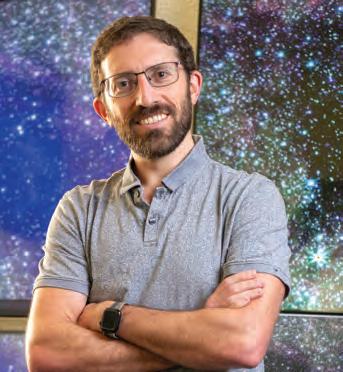
To study the early universe, astronomers must find distant objects, which we see as they were billions of years ago. To see that far away, they use the universe’s largest magnifying lens.
“Just as you can magnify light with a glass lens, you can magnify light with very large masses,” Gonzalez says. The team is studying four galaxies that are magnified 10 to 40 times their size by this gravitational lensing effect, helping them see more distant objects up close.
These early stars and galaxies permanently changed the universe by producing brand new elements, including those that allowed life to form.

“As the universe evolves, and star formation keeps happening and stars explode, you start to get more and more heavy elements until you get to today, where you have super heavy elements, even uranium,” Narayanan explained. This increasing abundance of heavy elements drives the evolution of galaxies from shortly after the Big Bang to what we see today.
Gonzalez and Narayanan are extending the models of this galactic evolution back to the earliest galaxies. Scientists measure the elemental composition of galaxies by looking at the signatures these elements leave in the light coming from those galaxies. These methods work well for nearby galaxies.
“But nobody knows if these methods work for early universe galaxies,” Narayanan says. “For all this time, we’ve only had theoretical models. We’ve never had observational data. And now, for the first time, we’re going to start to get a sense of how the chemical evolution of galaxies has evolved through the dawn of time.”
As Adam Ginsburg began studying astronomy, he discovered that most of the big questions he wanted to answer about the cosmos came down to one unsolved riddle: Why are big stars big and small stars small?
“Every question I asked, no matter what it was, all pointed back to this fundamental problem,” says Ginsburg, a professor of astronomy at UF.
The JWST is providing Ginsburg and his team their best chance yet to solve this
Delving into the cosmos with the James Webb Space Telescope Anthony Gonzalezunanswered question, known in astronomy as the initial mass function.
“We’re trying to figure out how stars form,” Ginsburg says. “To study this, we’re looking at the center of our galaxy. It’s a special place because it has a lot more stars around, a lot more gas around.”
His research group is turning the telescope on a busy cloud of gas near the center of the galaxy jokingly called “the brick” because it is so difficult to see through. But thanks to the telescope’s work in infrared wavelengths, Ginsburg will get to peer inside the thick gas to search for young stars. By catching stars that are still growing, Ginsburg can start to answer why they grow to the sizes that they do, putting the puzzle pieces into place to answer deeper questions about our universe.
Astronomers have it tough, says astronomy Professor Jaehan Bae. They can’t set up experiments of galaxies crashing into one another or supernovas exploding. To answer how the universe works, astronomers have to look for natural experiments in the night sky.
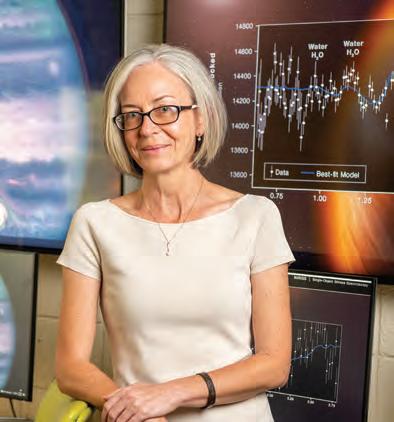

For Bae, who studies the formation of planets, that means finding baby planets as they’re just coming together.
“The best way to do this is to observe planets that are still forming somewhere else in the universe. This has become possible in the last few years thanks to the increasing capability of observing facilities,” Bae says.
In recent years, Bae’s team has used ground-based observatories to discover indirect evidence of planets forming in the disks of material that surround young stars. But the best analysis would come from a clear image of infrared wavelengths, the kind of heat signatures that Earth’s atmosphere interferes with – but that the JWST excels in capturing from space.
“What we really need is the direct image of those planets. It’s really challenging to do that from a ground-based telescope,” Bae says. “That’s where James Webb will be really helpful. We can look at these planets in infrared wavelengths.”
Just a couple decades ago, humanity first learned that other stars have their own planets. Today, the number of confirmed exoplanets — those orbiting stars other than our own — numbers in the thousands. As the James Webb Space Telescope prepares to survey countless more, the question on everyone’s mind is: Do these other worlds harbor life?
“It’s a question of finding life and recognizing it,” says Katia Matcheva, a UF professor of physics.
When the planets are a thousand light-years away, that’s no
easy feat. To help in the effort, Matcheva’s team is developing improved models to analyze the light that passes by exoplanets as they transit in front of their stars.
“If the planet has an atmosphere, you can get an imprint of the chemical composition of the planet,” Matcheva says.
Signs of water, oxygen or other lifesupporting molecules could mean that life took hold on these exoplanets. But scientists are still puzzling out what would qualify as a clear signature of alien life in the data.
The JWST’s work in infrared is ideal for studying planetary atmospheres. But with so much high-quality data pouring in, the problem will become analyzing it all. So Matcheva and her collaborator Konstantin Matchev are preparing machine-learning systems to assist in deciphering this avalanche of data so scientists can be more confident in identifying unambiguous signs of life — if it’s out there.
Imagine a small city that manages to pack in the mass of the entire sun.
That’s what life is like for neutron stars, the most extreme cosmic objects short of black holes. Neutron stars form from the husks of a dying star that collapses under its own immense gravity. Occasionally, two neutron stars collide, and the resulting explosion creates a smorgasbord of new elements.
“We know now that the collision of these neutron stars is likely responsible for most of the heavy elements we can find in the universe and on Earth itself,” says physics Professor Imre Bartos.

“These are very important cosmic events. However, we still have very limited information about how this process unfolds.”
Bartos is a member of the LIGO gravitational-wave observatory. LIGO uses hyper-accurate lasers and mirrors to detect ripples in spacetime when massive objects like neutron stars and black holes collide. But what LIGO can’t see is light. That’s where the James Webb Space Telescope comes in.
“The process of creating these heavy elements has its signature
Jaehan Bae Imre Bartosin infrared light. The James Webb telescope is almost custommade to observe these events,” Bartos says.
By combining observations of gravitational waves and infrared light from the telescope, Bartos hopes to come away with a clearer understanding of how the universe seeded itself with the heaviest elements — gold, platinum, uranium — that enrich life on Earth.
At the center of every galaxy, including the Milky Way, sits a supermassive black hole, which might reach a billion times the mass of the sun. Physics Professor Laura Blecha is trying to understand how these behemoths form and evolve over billions of years.
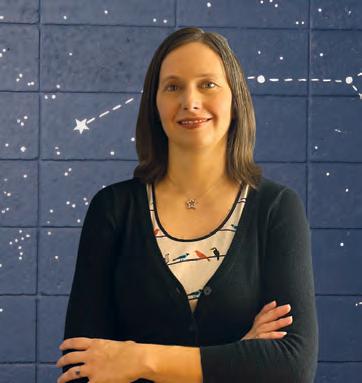
How do you study an object famous for its ability to let nothing, not even light, escape? Look for the swirl of gas energized by intense gravity as it falls into the void.

“JWST, because it has much better sensitivity, and it’s going to be able to observe things at very early times in the universe, is going to be good for detecting the signals from the fainter black holes,” Blecha says. “So that’s going to help us understand a lot more about how these black holes form and grow.”
Blecha is developing models that can simulate the different possible ways the earliest of these supermassive black holes might have formed. Data from James Webb could help determine which of these models of the early universe is correct.
The new telescope’s infrared vision will also help Blecha study the changes that occur when two galaxies, and their central black holes, merge together.

“There’s evidence that some of these systems have black holes that are going through rapid periods of growth,” Blecha says. “All that chaos creates a lot of dust in the center of the galaxy that obscures light coming from the accreting black hole. Because JWST sees it in infrared, it can see through that dust better and give us a look inside.”
In astronomy, distance is everything. It’s also incredibly difficult to come by.
An object in the night sky could be dim and nearby or bright and far away. Within the Milky Way, some straightforward geometry might be all you need to tell the difference. But for “way, way out there,” you need something better.
Enter supernovas. The deaths of stars much more massive than our sun are always marked by these extraordinary celestial explosions. But under very special circumstances, a star the size of our sun can also lead to such a fantastic display of energy, called a Type 1a supernova, resulting from the overflow of matter from a close companion star.
“When they explode, it seems to be the case that they all reach the same peak in luminosity and drop off in brightness at the same rate,” said Charles Telesco, a professor of astronomy at UF. Referred to as standard candles, the consistent luminosity of these explosions makes their distance much easier to measure. “We can use them to measure the expansion of the universe at that distance.”
Telesco specializes in designing and constructing astrophysical detector systems. He got into supernovas when an instrument that he and his UF team designed for UF’s telescope in Spain — tuned to just the right kind of infrared light — captured in fine detail a nearby supernova.

Now working with the latest infrared observatory, the James Webb Space Telescope, Telesco is part of a team that will monitor Type 1a supernovas to understand their nature and test assumptions that scientists have relied on to determine that the universe is expanding at an accelerating rate.
“We want to be able to characterize these standard candles better and to know if there are corrections that need to be made to our observations,” Telesco said.
Eric Hamilton Charles TelescoAstronomers have identified one of the youngest exoplanets ever discovered, hidden in the swirl of gas around a newly born star 390 light-years from Earth.
The Jupiter-sized world offers two key opportunities to scientists studying how all planets, including those in our own solar system, develop. A mere 1.5-million-yearold infant compared to its probable lifespan of billions of years, the planet is so young it can still provide clues about its birth. And this study marks the first time astronomers have analyzed an exoplanet’s surrounding disk of gas, which not only provides more information about the planet’s past but also how its future moons will develop.
“The best way to study planet formation is to observe planets while they’re forming,” said Jaehan Bae, the UF astronomy professor who led the new discovery.
Bae and his international team of collaborators, including UF doctoral student Maria Galloway-Sprietsma, published their findings in The Astrophysical Journal Letters.
C lues to our past
“I was always curious to learn how our solar system planets had formed in the past,” Bae said. “We can study planets in our solar system directly in many ways. We can get samples of planets, asteroids and comets. But we still can’t see what happened in the past.”
The next best thing to seeing into our own solar system’s history is for scientists like Bae to study the birth of exoplanets, those worlds that orbit stars other than our own sun. So Bae’s team turned to ALMA, a clever array of dozens of radio antennas in the Atacama Desert of northern Chile
that is powerful enough to spot these far flung planets. By combining signals from antennas spread across miles of desert, ALMA acts as a single, enormous telescope.
The research group focused on a young star system known as AS 209, one of five stars being studied as a part of a broader ALMA program, known as MAPS, designed to expand out understanding of the chemistry of planet formation.
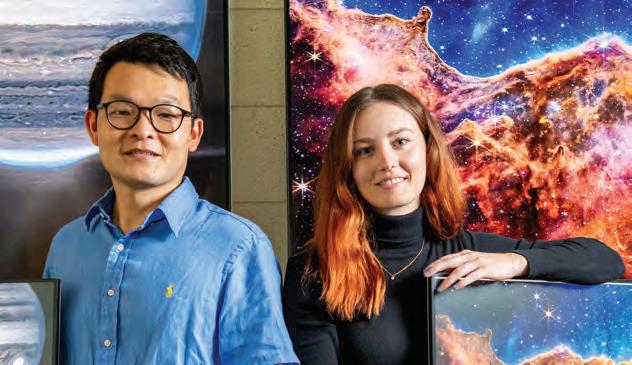
Scientists can look for clues in each star’s circumstellar disk, the flattened circle of material leftover after the star coalesces in the center of the system. Our solar system once hosted such a disk, and it eventually coalesced into the eight planets.
The AS 209 circumstellar disk has several distinct rings, akin to the rings surrounding Saturn. After analyzing gaps in these rings and other anomalies in the AS 209 disk, the researchers identified the young planet, surrounded by a cloud of material known as a circumplanetary disk.
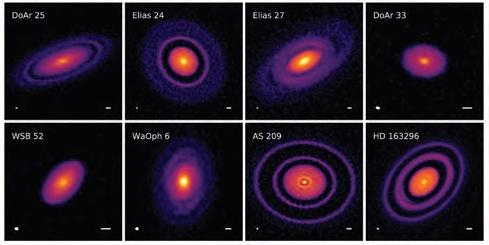
Because the new study is the first to measure the gas of this surrounding material, it provides a much more complete picture of planet formation than previous studies could accomplish.
“Most of the circumplanetary disk mass is in the gas, not the solid particles. If you see only solid particles in the system, then you’re studying a minor component of the disk,” Bae said. “And in fact one thing we found is the gas-to-dust mass ratio is much, much larger than previously expected, at least 1,000-to-1.”
While the planet’s young age and surrounding gas will help astronomers answer existing questions about planet
formation, the planet offers up new mysteries of its own.
Namely: How did it form so far away from its own star?
Bae’s team pinpointed the exoplanet at a whopping 200 astronomical units from the AS 209 star. One astronomical unit is the distance between the Earth and the sun. Neptune, the most distant planet, sits at 30 astronomical units, while Pluto orbits roughly 40 astronomical units out from the sun. Beyond that, as far as scientists know, lies nothing but a cloud of small asteroids, comets, and dwarf planets.
Bae’s team has proposed two main models for how the planet formed at this immense distance. In one, the young star’s own gravity jostled the leftover disk of material enough to seed a new planet. The other model relies on the planet seeding itself through the slow accumulation of tiny particles of solid material until there’s enough mass to form a large core.
But neither model sits neatly with the data. The circumstellar disk of the young star seems too small for its gravity to have initiated planet formation at this distance. At the same time, astronomers saw little evidence of the kind of tiny, grain-ofsand-sized particles that clump together to eventually form a planet’s core at the distance of the new exoplanet.
Fortunately, the researchers may not have to wait much longer to get a clearer picture of the planet’s unusual genesis. They have been approved for an early analysis with the new James Webb
Space Telescope. Eric Hamilton
Exoplanet researchers at the University of Florida are racking up honors at a rate that’s truly astronomical. Doctoral student Quadry Chance (right) is UF’s first NASA ExoExplorer and the first UF student to win a fellowship with the Center for Computational Astrophysics’ Flatiron Institute in New York City. Chance’s success inspired Christopher Lam and Sheila Sagear (middle) who also study planets beyond our solar system. Both applied for the highly competitive CCA fellowship, funded by the Simons Foundation, and were accepted. “To receive three awards is something really special,” says their advisor, astronomy Assistant Professor Sarah Ballard (left). “As a professor, you hope to do well advising and launching junior scientists. This is so affirming.”

